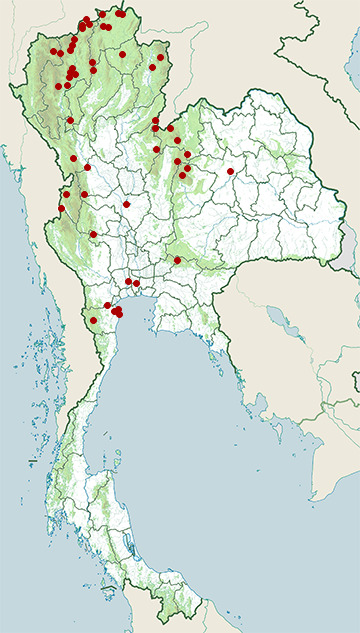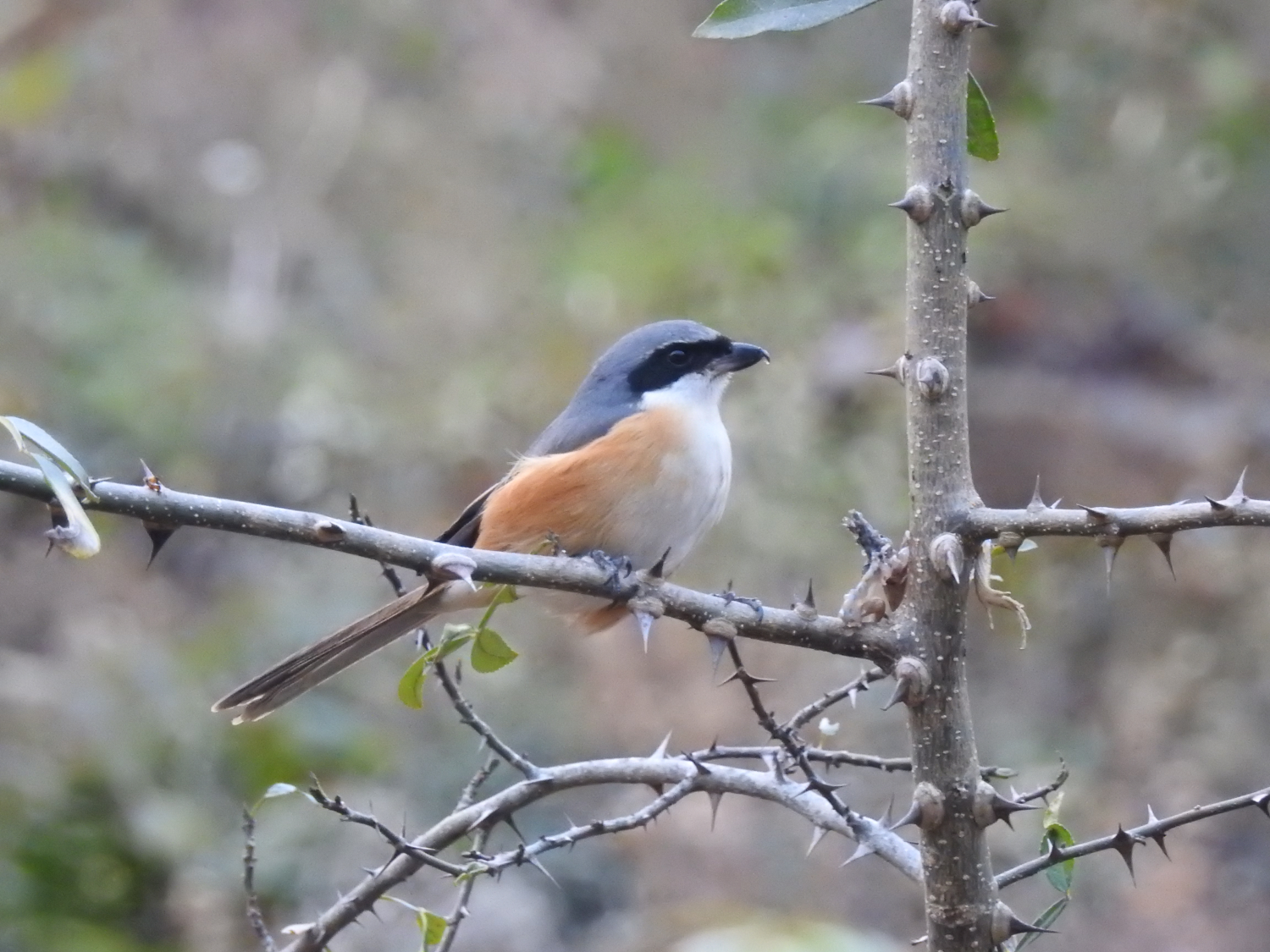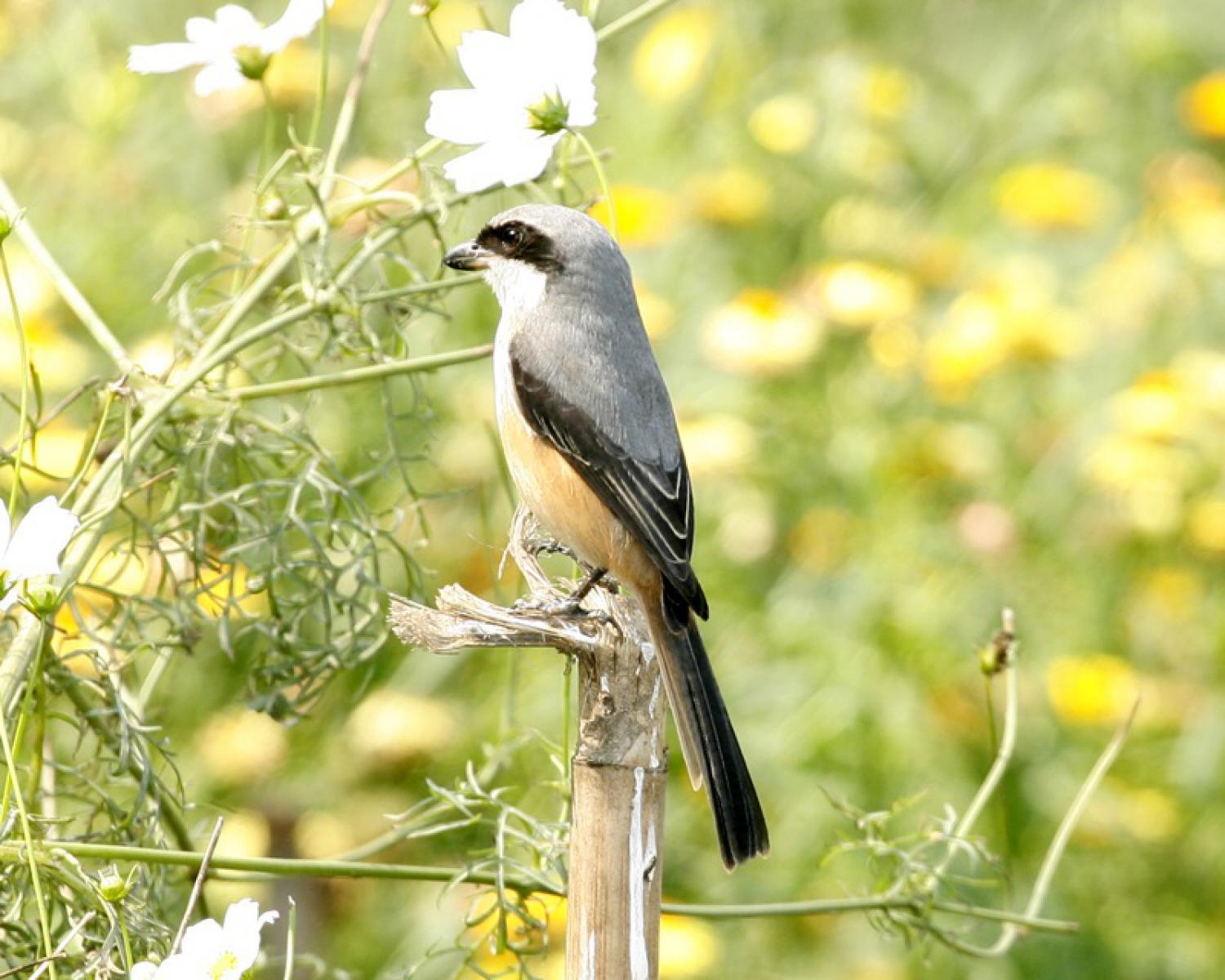Species of Thailand
Grey-backed shrike
Lanius tephronotus
Nicholas Aylward Vigors, 1831
In Thai: นกอีเสือหลังเทา
The grey-backed shrike (Lanius tephronotus) is a species of bird in the family Laniidae inhabiting the Asian South-east.
Taxonomy and systematics
The Grey-backed shrike was first described in 1831 by Nicholas Aylward Vigors as L. tephronotus collected near Darjeeling, India. It is closely allied with L. schach, and formerly treated as conspecific, but differs in morphology; moreover, the two species are largely sympatric and, although race lahulensis sometimes considered to represent a hybrid population between them, there is no definite proof of interbreeding. Two subspecies (L. t. lahulensis & L. t. tephronotus) are recognized.
Description
21–25 cm; 39-54g. Shrike with long tail. Nominate race has black lowermost forehead (just over base of bill) and facial mask through lores and eye to rear ear-coverts; crown to nape and most of upperparts dark grey, small rufous rump patch; upperwing black, most wing-coverts, secondaries and tertials fringed pale rufous to whitish, sometimes tiny white patch at base of primaries (often lacking); tail chestnut-brown, tipped buffish, outermost pair of rectrices light brown; throat and undertail brownish-grey; iris dark brown; bill black or dark green; legs dull black or dark green. Sexes very similar. Juvenile is browner above than adult, with less marked brown (not black) facial mask, horn-colored lower mandible, has crown finely barred, upperparts and much of underparts heavily barred dark brownish. Race lahulensis is smaller and weaker-billed than nominate, also much paler, brownish-grey above, with rufous lower back and rump, white primary patch usually slightly larger and more visible, tail sometimes blackish (not brown).
Voice: Rough, breathing-like call. Territorial call described as harsh "zzert-zzert…", "tchert-tchert…" or "tzert-tzert…"; repertoire includes also a repeated "ktcht-ktcht-ktcht" given at dusk or as alarm. Breeding song subdued and musical, with mimicry of other bird calls lasting several minutes. Voice seems to be similar to that of L. schach.
Distribution and habitat
The grey-backed shrike has two subspecies. L. t. lahulensis (Koelz, 1950) breeds from north Kashmir east to CN India (Uttaranchal Pradesh), and southwest China. L. t. tephronotus (Vigors, 1831) breeding range extends from Nepal east to northeast India (Arunachal Pradesh), and center and south China (S Gansu, Ningxia and E Shanxi S to southeast Qinghai, S & E Xizang, southeast Yunnan and C Guizhou); non-breeding distribution stretches south to Bangladesh, Myanmar, Thailand and Indochina.
Breeds at high elevations in forest clearings, plateau plains and mountain meadows dotted with small trees or fairly large bushes; to at least 4500 m in Nepal (becoming common from 2700 m upwards) and in south China (Yunnan). Post-breeding habitat in Sichuan (south China) either young open coniferous stands with forest clearings dominated by bushes, or pastures at higher elevations; at lower altitudes occurs in extensive agricultural valleys near human settlements. On non-breeding grounds in valleys and plains found in variety of habitats, including gardens and abandoned cultivation.
Breeding
The grey-backed shrikes nest between Jun-Jul in India and Apr-Jul/Aug (mainly May-Jun) in south China (Xizang), at elevations of 4010–4540 m with a delay in nesting time with increased elevation. Territorial; residents maintain territory throughout year. Nests were built mostly in bushes, 0.7-3m above ground. Nest a bulky, rather untidy-looking cap, external diameter 11–20 cm and height c. 8.5 cm, made mainly of moss, straw, rose stem, grass stem and brown palm, inlaid with Blue Eared-pheasant's feather and slender grass stem. Nests are placed about 2 m up in small tree or bush, either isolated or in streamside thicket or row of trees. Clutch 3-6 eggs and clutch size smaller for pairs that nested later at higher elevations. Female lay one egg each day after nested. Eggs pale grayish with numerous lavender marks and brown or grey-brown blotches or spots, and usually form rings at the blunt end. Incubation by females begin after the last egg been laid and last 15–18 days. During the incubation the females are reluctant to be away from her nest, and males act as nest-defenders, make a rapid "ga.ga.ga…" call when other animals approach the nest and fly to drive them away. Nestings are cared for by both parents for 14–15 days.
Compared with their lowland congeners, the grey-backed shrikes nesting in alpine habitats experienced shorter breeding seasons, produced fewer broods, smaller clutches, and larger eggs. They followed a life history strategy that allowed them to compensate for reduced annual fecundity under harsh conditions.
Food and feeding
Mostly insects, such as moths, crickets and grasshoppers (Orthoptera), beetles (Coleoptera) and caterpillars; small vertebrates, such as lizards, frogs, birds and small rodents, may also be consumed. The Grey-backed Shrikes are mainly sit-and-wait predators, often perching at the top of high grasses, bushes, or trees while looking for moving prey, so the availability of good quality perch sites in foraging areas is important for them. They taking prey mostly on ground but occasionally also hawk insects in the air. During the breeding season they only hunt within 150 meters near the nest. They also have the preference to impale prey and keep larder just as other shrikes.
Movements
Most individuals winter at lower altitudes within breeding range. Northwest race lahulensis appears to be resident or to descend to foothills of Himalayas, whereas nominate race either undertakes altitudinal movements or migrates to non-breeding areas farther south. Non-breeders recorded from plains of south China, India south to west Bengal, Bangladesh, Myanmar, north Thailand, Laos and north Vietnam. Migrants arrive back on breeding territories by early May. Chinese breeders appear to be mainly altitudinal migrants within their breeding range.
Relationship to humans
Grey-backed Shrike preferred sites close to human settlements, because these habitats offered a better foraging substrate and places safe from large predators. They appears to be naturally common across a widespread area and there is no evidence of them being globally threatened. But this species is more at risk if their habitats are altered by changes in land management activities, and high-elevation habitat considered more secure than lower-lying ones.
Status
The grey-backed shrike has an extremely large range and appears to be naturally common across a widespread area. The population trend appears to be stable, and hence the species does not approach the thresholds for Vulnerable under the population trend criterion (>30% decline over ten years or three generations). The population size has not been quantified, but it is not believed to approach the thresholds for Vulnerable under the population size criterion (<10, 000 mature individuals with a continuing decline estimated to be >10% in ten years or three generations, or with a specified population structure). For these reasons the species is evaluated as Least Concern.
This article uses material from Wikipedia released under the Creative Commons Attribution-Share-Alike Licence 3.0. Eventual photos shown in this page may or may not be from Wikipedia, please see the license details for photos in photo by-lines.
Category / Seasonal Status
Wiki listed status (concerning Thai population): Winter visitor
BCST Category: Recorded in an apparently wild state within the last 50 years
BCST Seasonal status: Non-breeding visitor
Scientific classification
- Kingdom
- Animalia
- Phylum
- Chordata
- Class
- Aves
- Order
- Passeriformes
- Family
- Laniidae
- Genus
- Lanius
- Species
- Lanius tephronotus
Common names
- Thai: นกอีเสือหลังเทา
Conservation status

Least Concern (IUCN3.1)
Photos
Please help us review the bird photos if wrong ones are used. We can be reached via our contact us page.
Range Map

- Bangkok Province
- Bueng Boraped Non-Hunting Area
- Chae Son National Park
- Chiang Dao District, Chiang Mai
- Chiang Dao Wildlife Sanctuary
- Chiang Saen District, Chiang Rai
- Doi Inthanon National Park
- Doi Lang
- Doi Lo District, Chiang Mai
- Doi Pha Hom Pok National Park
- Doi Phu Kha National Park
- Doi Suthep - Pui National Park
- Fang District, Chiang Mai
- Huai Nam Dang National Park
- Kaeng Krachan National Park
- Khao Sanam Prieng Wildlife Sanctuary
- Khao Yai National Park
- Khao Yoi District, Phetchaburi
- Khon San District, Chaiyaphum
- Khun Chae National Park
- Laem Pak Bia
- Lam Nam Kok National Park
- Mae Ai District, Chiang Mai
- Mae Fa Luang District, Chiang Rai
- Mae Ping National Park
- Mae Rim District, Chiang Mai
- Mae Wong National Park
- Mueang Chiang Mai District, Chiang Mai
- Mueang Chiang Rai District, Chiang Rai
- Mueang Khon Kaen District, Khon Kaen
- Mueang Phetchaburi District, Phetchaburi
- Nam Nao National Park
- Nong Bong Khai Non-Hunting Area
- Op Khan National Park
- Pai District, Mae Hong Son
- Pak Thale
- Pha Daeng National Park
- Phu Hin Rong Kla National Park
- Phu Khiao Wildlife Sanctuary
- Phu Kradueng National Park
- Phu Luang Wildlife Sanctuary
- Phu Ruea National Park
- Phu Soi Dao National Park
- Phu Suan Sai National Park
- Phu Toei National Park
- Phutthamonthon District, Nakhon Pathom
- Taksin Maharat National Park
- Tham Sakoen National Park
- Thung Yai Naresuan Wildlife Sanctuary
- Umphang Wildlife Sanctuary
- Wiang Lo Wildlife Sanctuary

